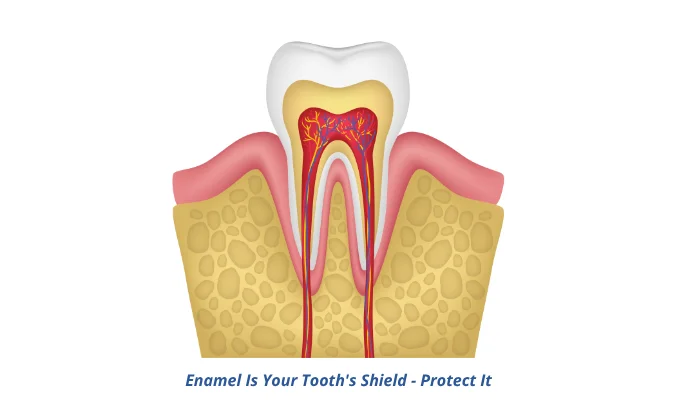
Every time you smile, laugh, or speak, you’re showcasing one of nature’s most remarkable engineering marvels. Your tooth enamel stands as the hardest substance in the human body, yet this irreplaceable shield faces constant attack from the foods you eat and the bacteria living in your mouth.
Understanding how tooth enamel protection works can transform the way your family approaches oral health. When you grasp the science behind enamel defense, you’re not just preventing cavities—you’re preserving your teeth for a lifetime of confident smiles.
The Incredible Architecture of Tooth Enamel
Picture your tooth enamel as nature’s fortress wall, built from millions of tiny mineral crystals called hydroxyapatite. These crystals pack together so tightly that enamel becomes harder than steel, creating a protective barrier that withstands decades of chewing and chemical exposure.Unlike other tissues in your body, enamel contains no living cells, which means it cannot regenerate or heal itself once damaged. This irreversible nature makes tooth enamel protection absolutely critical for long-term oral health.
The Hidden Battle: Demineralization vs. Remineralization
Your mouth operates as a dynamic environment where enamel constantly cycles between breakdown and repair. This process determines whether your teeth stay strong or develop cavities over time.Demineralization occurs when acids attack your enamel. Bacteria in your mouth feed on sugars and starches from food, producing acid that dissolves the mineral crystals in your enamel, creating tiny holes that can eventually become cavities.Remineralization represents your mouth’s natural repair system. Saliva contains calcium and phosphate ions that can rebuild weakened enamel areas, essentially patching these microscopic holes before they become permanent damage.The balance between these processes determines your cavity risk.
pH Levels: The Key to Enamel Health
Understanding pH levels in your mouth provides the key to controlling enamel health. Your enamel begins dissolving when pH drops below 5.5, known as the critical pH. Every time you eat or drink something containing sugars or acids, your mouth’s pH plummets into the danger zone for 20-40 minutes.Saliva acts as your mouth’s natural buffer, working to neutralize acids and restore healthy pH balance. However, frequent snacking can overwhelm this protective system, keeping your mouth acidic for hours.
Dietary Choices That Strengthen or Weaken Enamel
Your food choices directly impact the demineralization and remineralization cycle. Foods that support enamel remineralization include:
- Dairy products rich in calcium and phosphates
- Leafy green vegetables
- Nuts and fluoride-containing foods like tea
Conversely, frequent consumption of sugary snacks, acidic beverages, and sticky foods creates conditions that favor demineralization. Sodas, sports drinks, and fruit juices pose particular challenges because they combine sugar with acids.The timing of consumption matters more than the total amount. Sipping a sugary drink over several hours creates more enamel damage than drinking the same beverage quickly with a meal.
Fluoride’s Essential Role in Enamel Protection
Fluoride transforms enamel protection by making teeth more resistant to acid attacks while accelerating remineralization. When fluoride reaches your teeth, it creates fluorapatite that resists dissolution better than natural enamel.Multiple fluoride sources work together: fluoridated drinking water, fluoride toothpaste, and professional fluoride treatments provide comprehensive protection.
Practical Daily Strategies for Enamel Protection
Implementing effective enamel protection requires consistent daily habits:
- Consume acidic or sugary items with meals rather than as isolated snacks
- Wait 30 minutes after eating before brushing to avoid scrubbing softened enamel
- Use fluoride toothpaste twice daily
- Chew sugar-free gum after meals to stimulate saliva production
- Drink water to help dilute acids and restore neutral pH
Your Family’s Path to Lifelong Enamel Health
Understanding tooth enamel empowers you to make informed decisions that protect your family’s oral health for decades. By supporting your mouth’s natural remineralization processes while minimizing acid attacks, you create conditions where your enamel can remain strong and functional.Regular dental checkups ensure that your home care efforts achieve optimal results while catching any developing problems before they become serious concerns.
At Higher Ground Dentistry in Upland, Dr. Vikas Sikka and his bilingual team understand that every family’s enamel protection needs are unique. Ready to elevate your family’s tooth enamel protection strategy?Contact Higher Ground Dentistry at 909-946-9090 to schedule your consultation. Visit us at 121 W Foothill Blvd, Suite E, Upland, where we’re dedicated to helping every member of your family achieve a lifetime of healthy smiles that reach higher ground.


